The Significance of Cross-Cultural Communication in Public Relations
VerifiedAdded on 2023/06/04
|7
|1547
|224
Report
AI Summary
This report delves into the critical role of cross-cultural communication and diversity within the public relations landscape, particularly in the context of Australia's multicultural environment. It highlights how diversity, encompassing aspects like gender, race, and ethnicity, significantly influences the performance and effectiveness of PR practitioners. The report explores the implications of diversity, including enhanced empathy, improved communication, and the introduction of new approaches in handling PR challenges. It also addresses potential barriers like language issues and discrimination. Furthermore, it emphasizes the need for embracing diversity through practices like inclusive dialogue, leadership reflection, and focused message development. The conclusion underscores the value of multicultural practitioners in improving the public relations industry, advocating for the recognition of diversity as a cornerstone of successful PR strategies. The report references several academic sources, including books and journal articles, to support its claims.
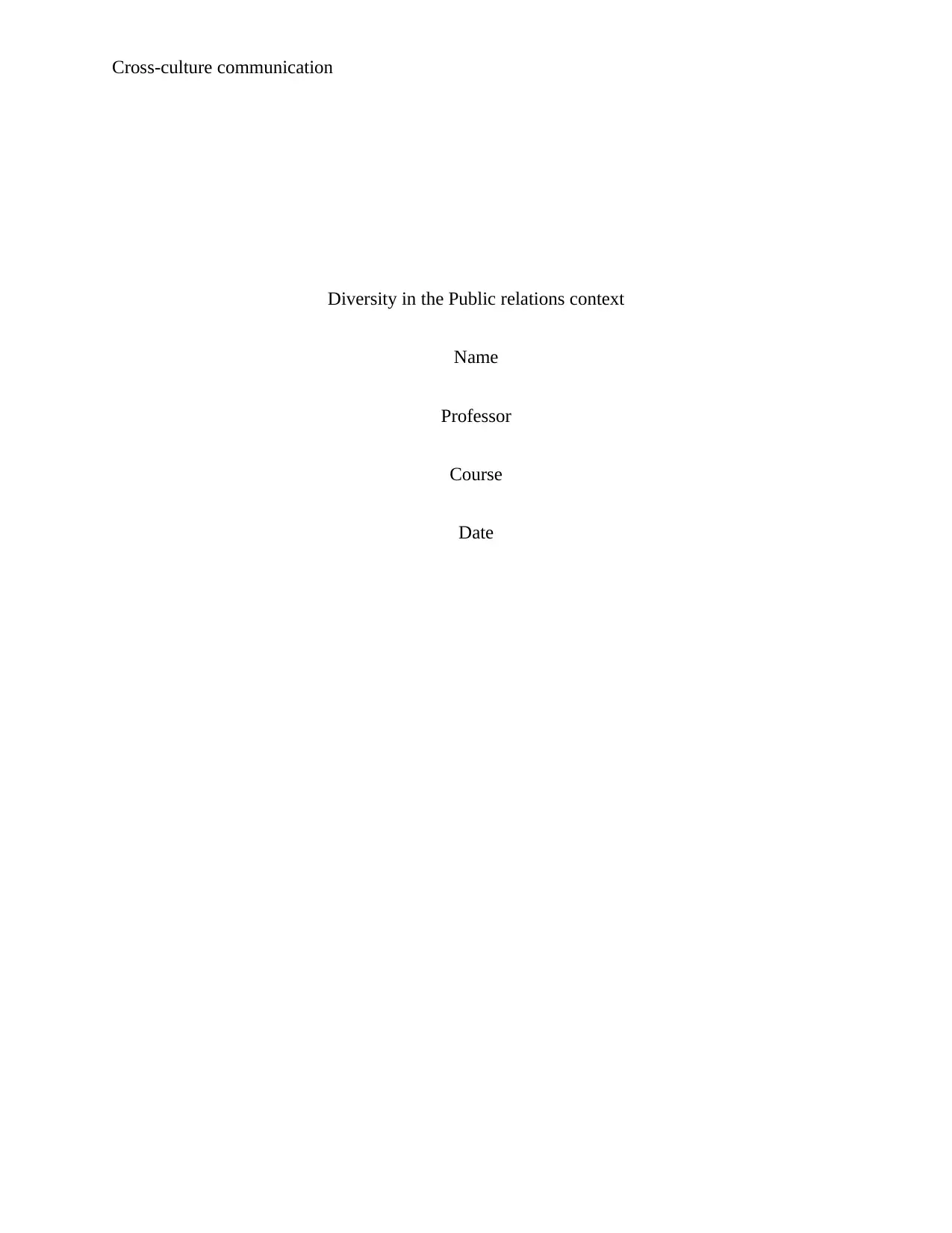
Cross-culture communication
Diversity in the Public relations context
Name
Professor
Course
Date
Diversity in the Public relations context
Name
Professor
Course
Date
Paraphrase This Document
Need a fresh take? Get an instant paraphrase of this document with our AI Paraphraser
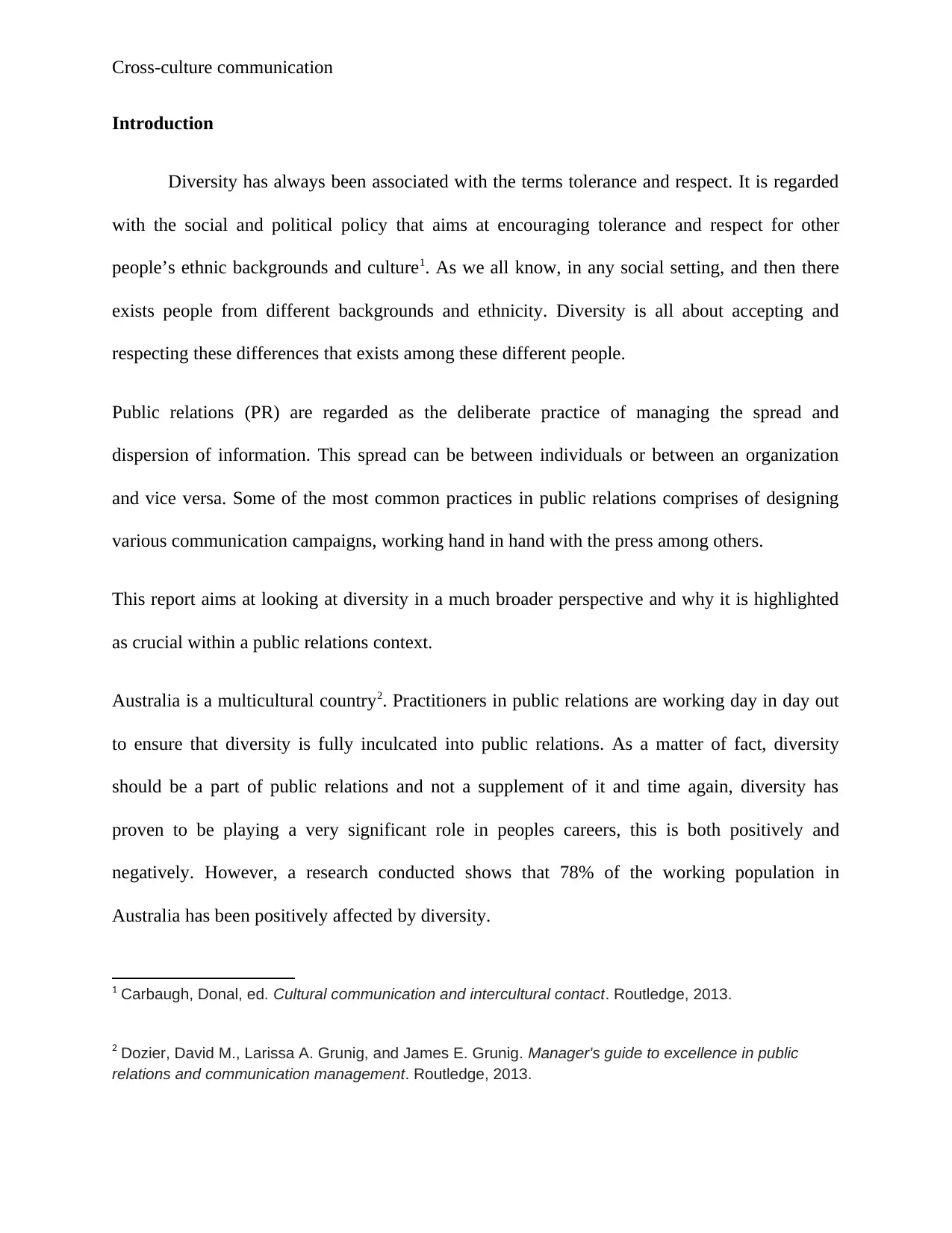
Cross-culture communication
Introduction
Diversity has always been associated with the terms tolerance and respect. It is regarded
with the social and political policy that aims at encouraging tolerance and respect for other
people’s ethnic backgrounds and culture1. As we all know, in any social setting, and then there
exists people from different backgrounds and ethnicity. Diversity is all about accepting and
respecting these differences that exists among these different people.
Public relations (PR) are regarded as the deliberate practice of managing the spread and
dispersion of information. This spread can be between individuals or between an organization
and vice versa. Some of the most common practices in public relations comprises of designing
various communication campaigns, working hand in hand with the press among others.
This report aims at looking at diversity in a much broader perspective and why it is highlighted
as crucial within a public relations context.
Australia is a multicultural country2. Practitioners in public relations are working day in day out
to ensure that diversity is fully inculcated into public relations. As a matter of fact, diversity
should be a part of public relations and not a supplement of it and time again, diversity has
proven to be playing a very significant role in peoples careers, this is both positively and
negatively. However, a research conducted shows that 78% of the working population in
Australia has been positively affected by diversity.
1 Carbaugh, Donal, ed. Cultural communication and intercultural contact. Routledge, 2013.
2 Dozier, David M., Larissa A. Grunig, and James E. Grunig. Manager's guide to excellence in public
relations and communication management. Routledge, 2013.
Introduction
Diversity has always been associated with the terms tolerance and respect. It is regarded
with the social and political policy that aims at encouraging tolerance and respect for other
people’s ethnic backgrounds and culture1. As we all know, in any social setting, and then there
exists people from different backgrounds and ethnicity. Diversity is all about accepting and
respecting these differences that exists among these different people.
Public relations (PR) are regarded as the deliberate practice of managing the spread and
dispersion of information. This spread can be between individuals or between an organization
and vice versa. Some of the most common practices in public relations comprises of designing
various communication campaigns, working hand in hand with the press among others.
This report aims at looking at diversity in a much broader perspective and why it is highlighted
as crucial within a public relations context.
Australia is a multicultural country2. Practitioners in public relations are working day in day out
to ensure that diversity is fully inculcated into public relations. As a matter of fact, diversity
should be a part of public relations and not a supplement of it and time again, diversity has
proven to be playing a very significant role in peoples careers, this is both positively and
negatively. However, a research conducted shows that 78% of the working population in
Australia has been positively affected by diversity.
1 Carbaugh, Donal, ed. Cultural communication and intercultural contact. Routledge, 2013.
2 Dozier, David M., Larissa A. Grunig, and James E. Grunig. Manager's guide to excellence in public
relations and communication management. Routledge, 2013.
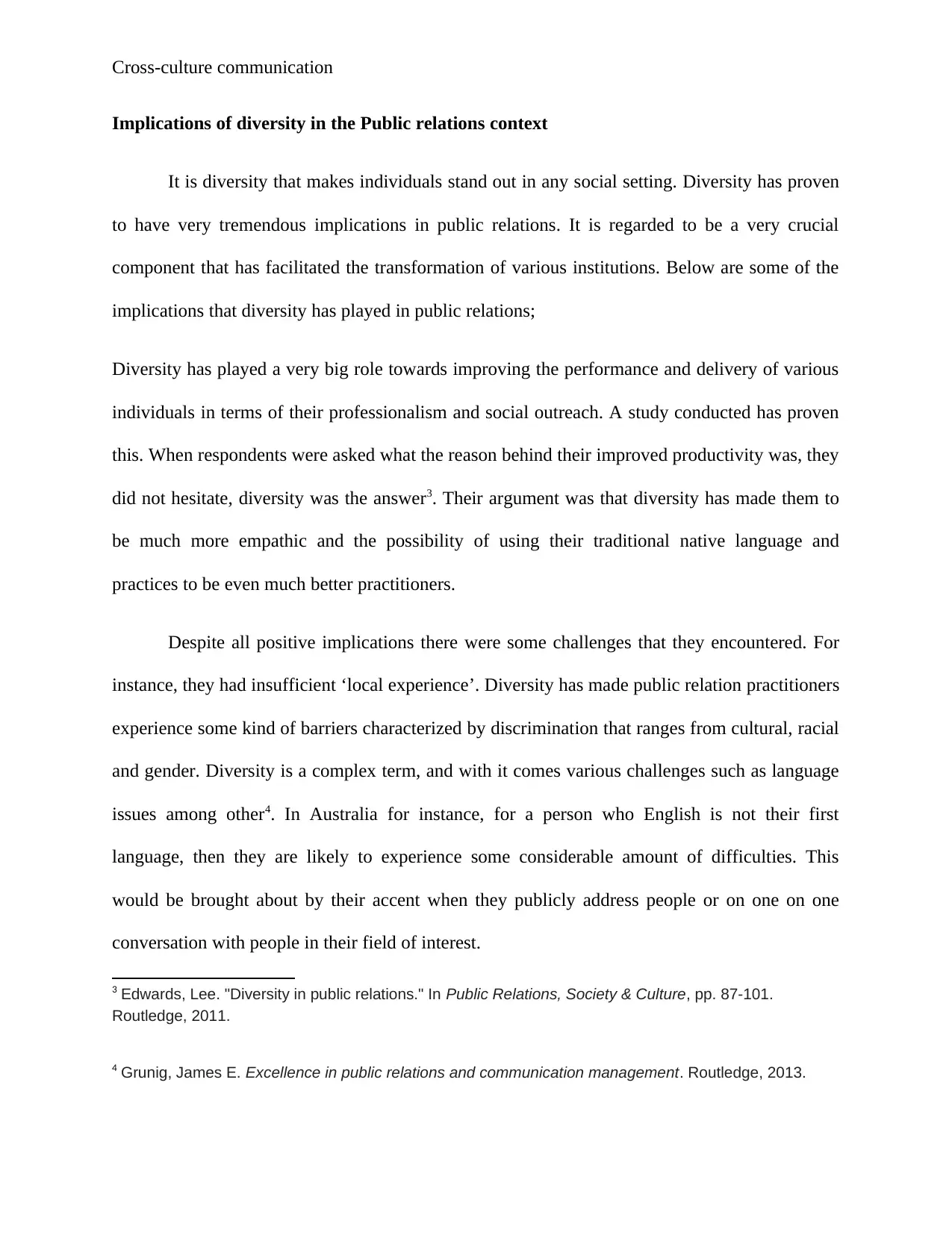
Cross-culture communication
Implications of diversity in the Public relations context
It is diversity that makes individuals stand out in any social setting. Diversity has proven
to have very tremendous implications in public relations. It is regarded to be a very crucial
component that has facilitated the transformation of various institutions. Below are some of the
implications that diversity has played in public relations;
Diversity has played a very big role towards improving the performance and delivery of various
individuals in terms of their professionalism and social outreach. A study conducted has proven
this. When respondents were asked what the reason behind their improved productivity was, they
did not hesitate, diversity was the answer3. Their argument was that diversity has made them to
be much more empathic and the possibility of using their traditional native language and
practices to be even much better practitioners.
Despite all positive implications there were some challenges that they encountered. For
instance, they had insufficient ‘local experience’. Diversity has made public relation practitioners
experience some kind of barriers characterized by discrimination that ranges from cultural, racial
and gender. Diversity is a complex term, and with it comes various challenges such as language
issues among other4. In Australia for instance, for a person who English is not their first
language, then they are likely to experience some considerable amount of difficulties. This
would be brought about by their accent when they publicly address people or on one on one
conversation with people in their field of interest.
3 Edwards, Lee. "Diversity in public relations." In Public Relations, Society & Culture, pp. 87-101.
Routledge, 2011.
4 Grunig, James E. Excellence in public relations and communication management. Routledge, 2013.
Implications of diversity in the Public relations context
It is diversity that makes individuals stand out in any social setting. Diversity has proven
to have very tremendous implications in public relations. It is regarded to be a very crucial
component that has facilitated the transformation of various institutions. Below are some of the
implications that diversity has played in public relations;
Diversity has played a very big role towards improving the performance and delivery of various
individuals in terms of their professionalism and social outreach. A study conducted has proven
this. When respondents were asked what the reason behind their improved productivity was, they
did not hesitate, diversity was the answer3. Their argument was that diversity has made them to
be much more empathic and the possibility of using their traditional native language and
practices to be even much better practitioners.
Despite all positive implications there were some challenges that they encountered. For
instance, they had insufficient ‘local experience’. Diversity has made public relation practitioners
experience some kind of barriers characterized by discrimination that ranges from cultural, racial
and gender. Diversity is a complex term, and with it comes various challenges such as language
issues among other4. In Australia for instance, for a person who English is not their first
language, then they are likely to experience some considerable amount of difficulties. This
would be brought about by their accent when they publicly address people or on one on one
conversation with people in their field of interest.
3 Edwards, Lee. "Diversity in public relations." In Public Relations, Society & Culture, pp. 87-101.
Routledge, 2011.
4 Grunig, James E. Excellence in public relations and communication management. Routledge, 2013.
⊘ This is a preview!⊘
Do you want full access?
Subscribe today to unlock all pages.

Trusted by 1+ million students worldwide
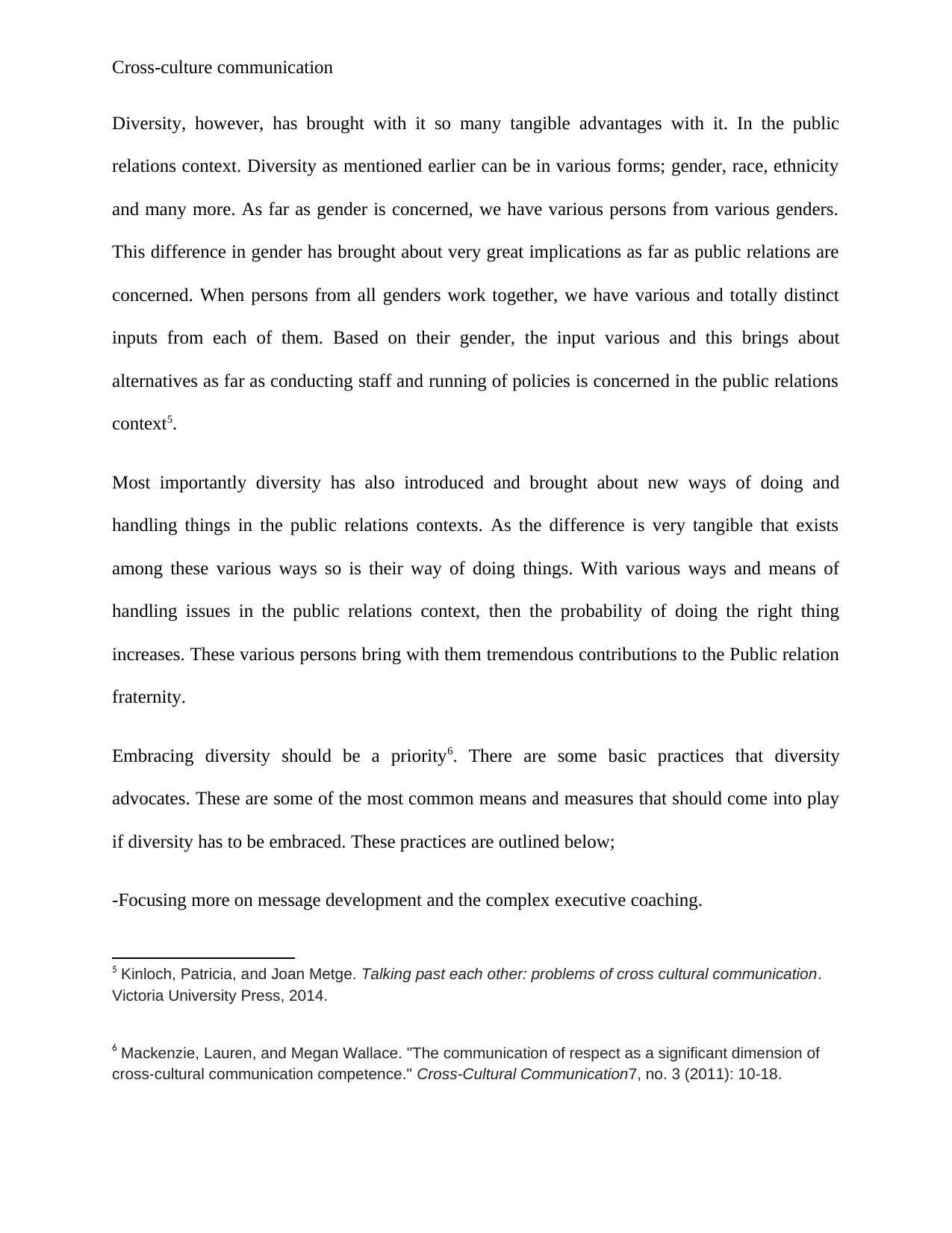
Cross-culture communication
Diversity, however, has brought with it so many tangible advantages with it. In the public
relations context. Diversity as mentioned earlier can be in various forms; gender, race, ethnicity
and many more. As far as gender is concerned, we have various persons from various genders.
This difference in gender has brought about very great implications as far as public relations are
concerned. When persons from all genders work together, we have various and totally distinct
inputs from each of them. Based on their gender, the input various and this brings about
alternatives as far as conducting staff and running of policies is concerned in the public relations
context5.
Most importantly diversity has also introduced and brought about new ways of doing and
handling things in the public relations contexts. As the difference is very tangible that exists
among these various ways so is their way of doing things. With various ways and means of
handling issues in the public relations context, then the probability of doing the right thing
increases. These various persons bring with them tremendous contributions to the Public relation
fraternity.
Embracing diversity should be a priority6. There are some basic practices that diversity
advocates. These are some of the most common means and measures that should come into play
if diversity has to be embraced. These practices are outlined below;
-Focusing more on message development and the complex executive coaching.
5 Kinloch, Patricia, and Joan Metge. Talking past each other: problems of cross cultural communication.
Victoria University Press, 2014.
6 Mackenzie, Lauren, and Megan Wallace. "The communication of respect as a significant dimension of
cross-cultural communication competence." Cross-Cultural Communication7, no. 3 (2011): 10-18.
Diversity, however, has brought with it so many tangible advantages with it. In the public
relations context. Diversity as mentioned earlier can be in various forms; gender, race, ethnicity
and many more. As far as gender is concerned, we have various persons from various genders.
This difference in gender has brought about very great implications as far as public relations are
concerned. When persons from all genders work together, we have various and totally distinct
inputs from each of them. Based on their gender, the input various and this brings about
alternatives as far as conducting staff and running of policies is concerned in the public relations
context5.
Most importantly diversity has also introduced and brought about new ways of doing and
handling things in the public relations contexts. As the difference is very tangible that exists
among these various ways so is their way of doing things. With various ways and means of
handling issues in the public relations context, then the probability of doing the right thing
increases. These various persons bring with them tremendous contributions to the Public relation
fraternity.
Embracing diversity should be a priority6. There are some basic practices that diversity
advocates. These are some of the most common means and measures that should come into play
if diversity has to be embraced. These practices are outlined below;
-Focusing more on message development and the complex executive coaching.
5 Kinloch, Patricia, and Joan Metge. Talking past each other: problems of cross cultural communication.
Victoria University Press, 2014.
6 Mackenzie, Lauren, and Megan Wallace. "The communication of respect as a significant dimension of
cross-cultural communication competence." Cross-Cultural Communication7, no. 3 (2011): 10-18.
Paraphrase This Document
Need a fresh take? Get an instant paraphrase of this document with our AI Paraphraser
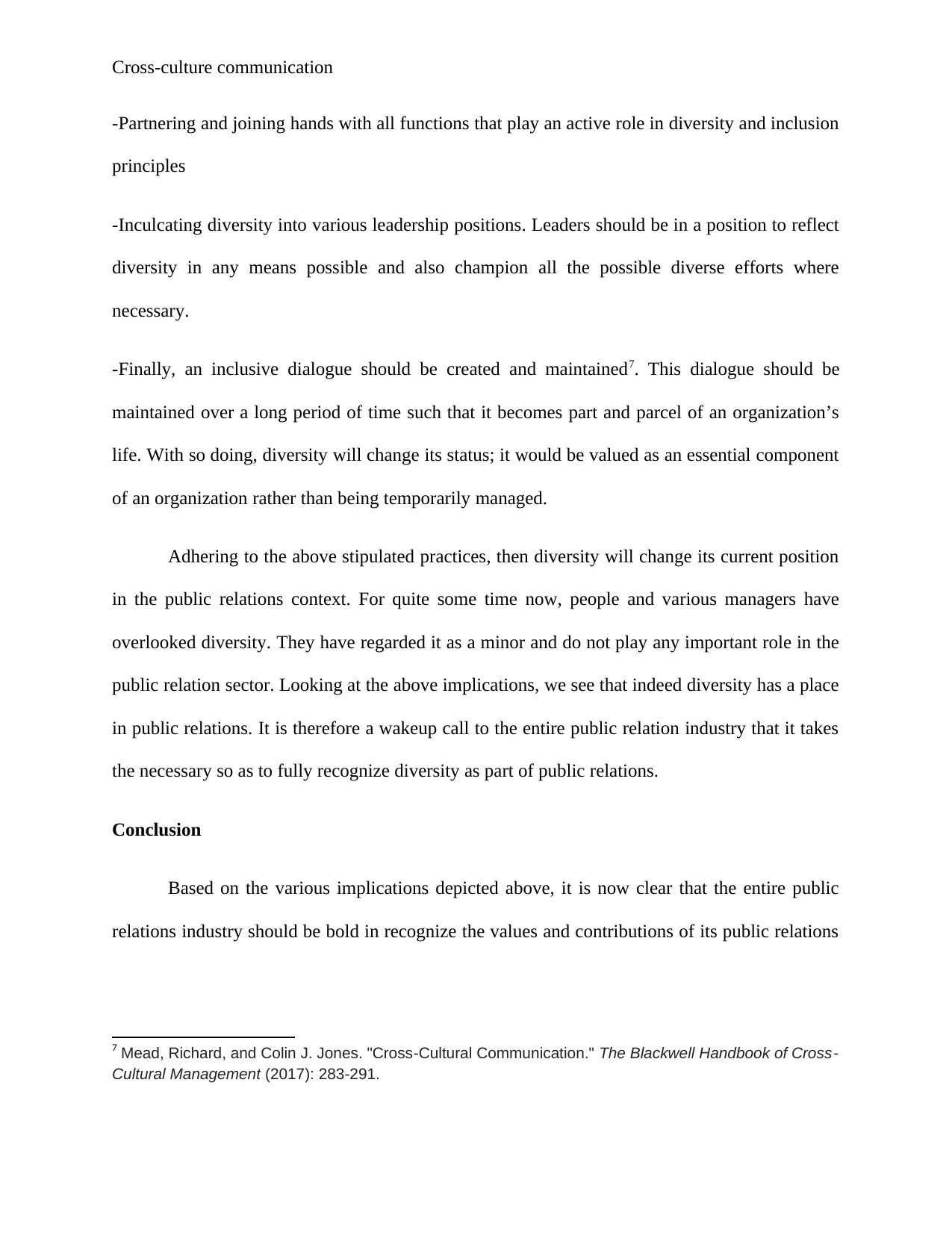
Cross-culture communication
-Partnering and joining hands with all functions that play an active role in diversity and inclusion
principles
-Inculcating diversity into various leadership positions. Leaders should be in a position to reflect
diversity in any means possible and also champion all the possible diverse efforts where
necessary.
-Finally, an inclusive dialogue should be created and maintained7. This dialogue should be
maintained over a long period of time such that it becomes part and parcel of an organization’s
life. With so doing, diversity will change its status; it would be valued as an essential component
of an organization rather than being temporarily managed.
Adhering to the above stipulated practices, then diversity will change its current position
in the public relations context. For quite some time now, people and various managers have
overlooked diversity. They have regarded it as a minor and do not play any important role in the
public relation sector. Looking at the above implications, we see that indeed diversity has a place
in public relations. It is therefore a wakeup call to the entire public relation industry that it takes
the necessary so as to fully recognize diversity as part of public relations.
Conclusion
Based on the various implications depicted above, it is now clear that the entire public
relations industry should be bold in recognize the values and contributions of its public relations
7 Mead, Richard, and Colin J. Jones. "Cross‐Cultural Communication." The Blackwell Handbook of Cross
‐
Cultural Management (2017): 283-291.
-Partnering and joining hands with all functions that play an active role in diversity and inclusion
principles
-Inculcating diversity into various leadership positions. Leaders should be in a position to reflect
diversity in any means possible and also champion all the possible diverse efforts where
necessary.
-Finally, an inclusive dialogue should be created and maintained7. This dialogue should be
maintained over a long period of time such that it becomes part and parcel of an organization’s
life. With so doing, diversity will change its status; it would be valued as an essential component
of an organization rather than being temporarily managed.
Adhering to the above stipulated practices, then diversity will change its current position
in the public relations context. For quite some time now, people and various managers have
overlooked diversity. They have regarded it as a minor and do not play any important role in the
public relation sector. Looking at the above implications, we see that indeed diversity has a place
in public relations. It is therefore a wakeup call to the entire public relation industry that it takes
the necessary so as to fully recognize diversity as part of public relations.
Conclusion
Based on the various implications depicted above, it is now clear that the entire public
relations industry should be bold in recognize the values and contributions of its public relations
7 Mead, Richard, and Colin J. Jones. "Cross‐Cultural Communication." The Blackwell Handbook of Cross
‐
Cultural Management (2017): 283-291.
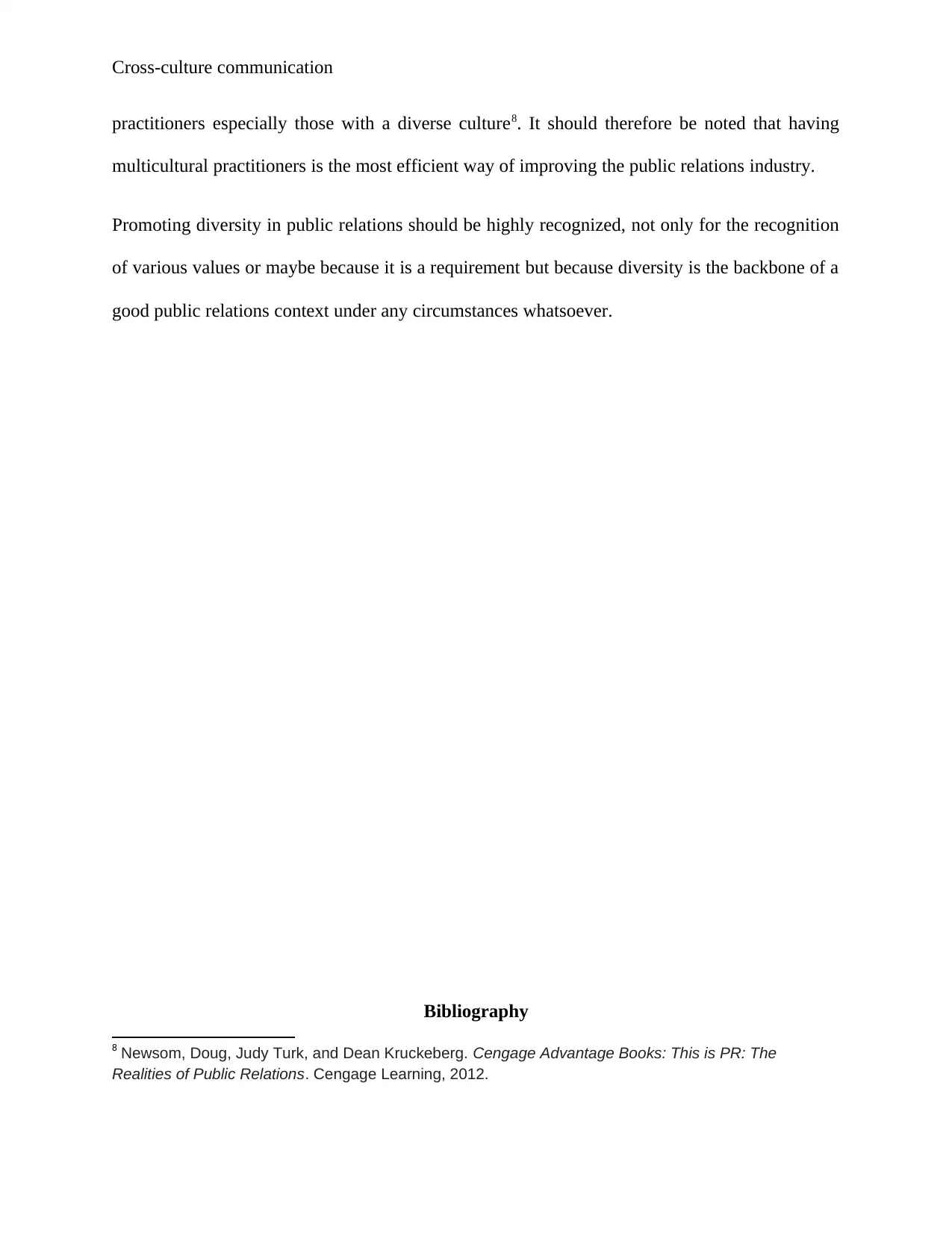
Cross-culture communication
practitioners especially those with a diverse culture8. It should therefore be noted that having
multicultural practitioners is the most efficient way of improving the public relations industry.
Promoting diversity in public relations should be highly recognized, not only for the recognition
of various values or maybe because it is a requirement but because diversity is the backbone of a
good public relations context under any circumstances whatsoever.
Bibliography
8 Newsom, Doug, Judy Turk, and Dean Kruckeberg. Cengage Advantage Books: This is PR: The
Realities of Public Relations. Cengage Learning, 2012.
practitioners especially those with a diverse culture8. It should therefore be noted that having
multicultural practitioners is the most efficient way of improving the public relations industry.
Promoting diversity in public relations should be highly recognized, not only for the recognition
of various values or maybe because it is a requirement but because diversity is the backbone of a
good public relations context under any circumstances whatsoever.
Bibliography
8 Newsom, Doug, Judy Turk, and Dean Kruckeberg. Cengage Advantage Books: This is PR: The
Realities of Public Relations. Cengage Learning, 2012.
⊘ This is a preview!⊘
Do you want full access?
Subscribe today to unlock all pages.

Trusted by 1+ million students worldwide
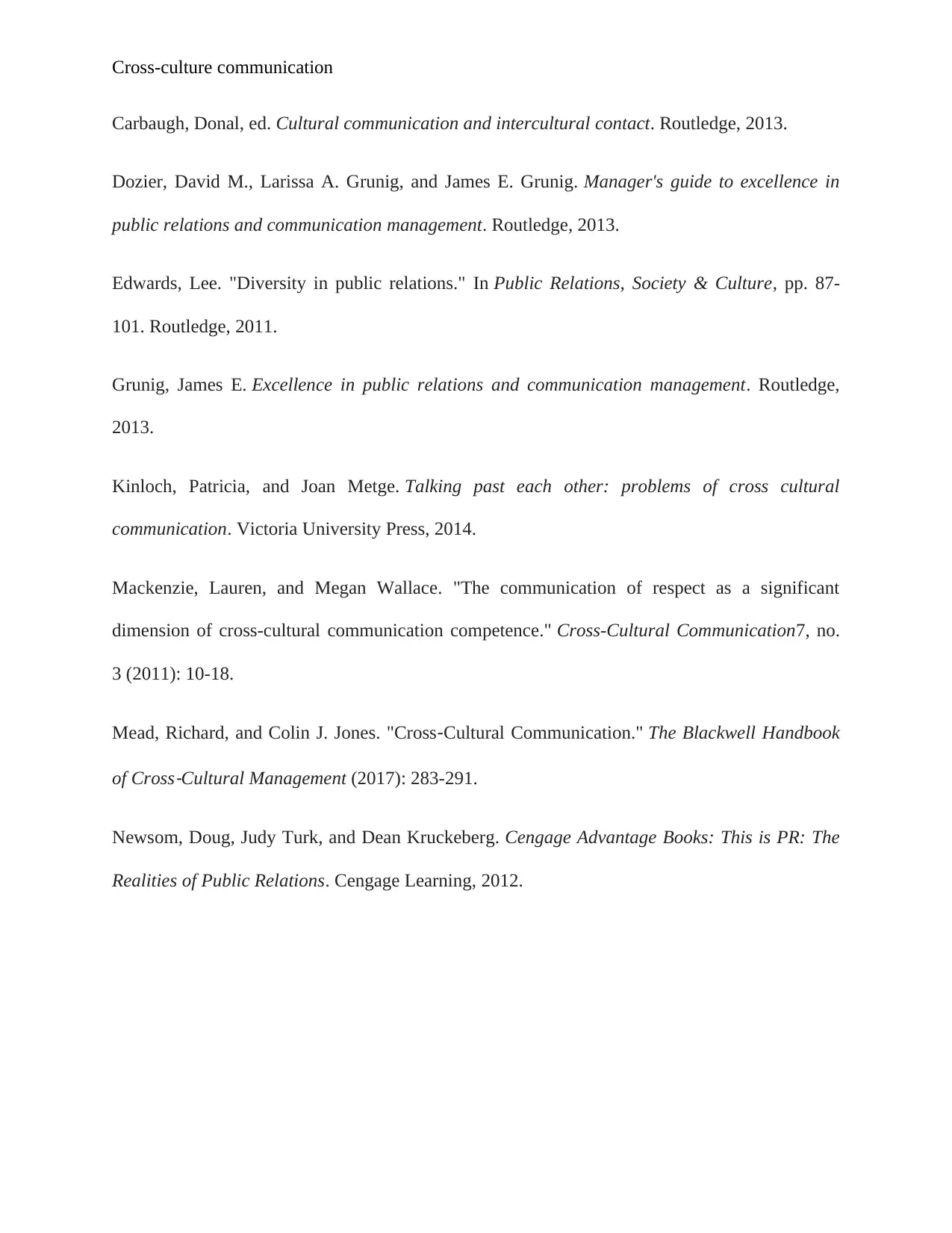
Cross-culture communication
Carbaugh, Donal, ed. Cultural communication and intercultural contact. Routledge, 2013.
Dozier, David M., Larissa A. Grunig, and James E. Grunig. Manager's guide to excellence in
public relations and communication management. Routledge, 2013.
Edwards, Lee. "Diversity in public relations." In Public Relations, Society & Culture, pp. 87-
101. Routledge, 2011.
Grunig, James E. Excellence in public relations and communication management. Routledge,
2013.
Kinloch, Patricia, and Joan Metge. Talking past each other: problems of cross cultural
communication. Victoria University Press, 2014.
Mackenzie, Lauren, and Megan Wallace. "The communication of respect as a significant
dimension of cross-cultural communication competence." Cross-Cultural Communication7, no.
3 (2011): 10-18.
Mead, Richard, and Colin J. Jones. "Cross‐Cultural Communication." The Blackwell Handbook
of Cross
‐Cultural Management (2017): 283-291.
Newsom, Doug, Judy Turk, and Dean Kruckeberg. Cengage Advantage Books: This is PR: The
Realities of Public Relations. Cengage Learning, 2012.
Carbaugh, Donal, ed. Cultural communication and intercultural contact. Routledge, 2013.
Dozier, David M., Larissa A. Grunig, and James E. Grunig. Manager's guide to excellence in
public relations and communication management. Routledge, 2013.
Edwards, Lee. "Diversity in public relations." In Public Relations, Society & Culture, pp. 87-
101. Routledge, 2011.
Grunig, James E. Excellence in public relations and communication management. Routledge,
2013.
Kinloch, Patricia, and Joan Metge. Talking past each other: problems of cross cultural
communication. Victoria University Press, 2014.
Mackenzie, Lauren, and Megan Wallace. "The communication of respect as a significant
dimension of cross-cultural communication competence." Cross-Cultural Communication7, no.
3 (2011): 10-18.
Mead, Richard, and Colin J. Jones. "Cross‐Cultural Communication." The Blackwell Handbook
of Cross
‐Cultural Management (2017): 283-291.
Newsom, Doug, Judy Turk, and Dean Kruckeberg. Cengage Advantage Books: This is PR: The
Realities of Public Relations. Cengage Learning, 2012.
1 out of 7
Related Documents
Your All-in-One AI-Powered Toolkit for Academic Success.
+13062052269
info@desklib.com
Available 24*7 on WhatsApp / Email
![[object Object]](/_next/static/media/star-bottom.7253800d.svg)
Unlock your academic potential
Copyright © 2020–2025 A2Z Services. All Rights Reserved. Developed and managed by ZUCOL.





